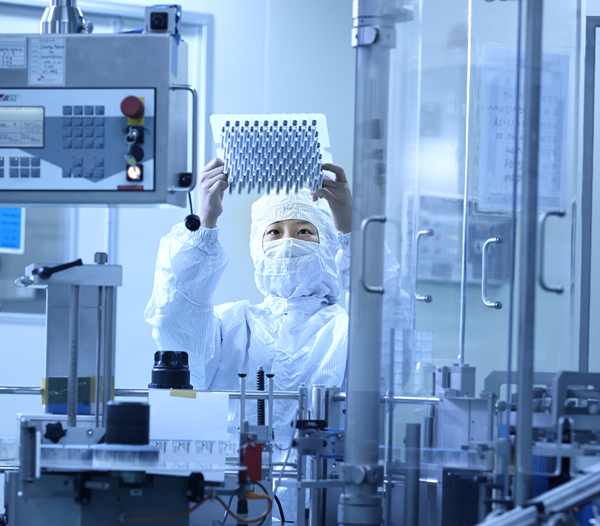● Approval of Clinical Testing of Cell-Cultured Quadrivalent Influenza Vaccine Developed by SK Chemical
- Proactive preparations for flu epidemic with global level quality and safety
- Capability for prompt, self-sufficient production of vaccine in the event of a national crisisSK Chemical is seeking to develop a cell-cultured quadrivalent influenza (flu) vaccine to cope with variants and epidemics of the influenza virus.
On 7 February 2014, the company announced that its plan for clinical testing of quadrivalent influenza vaccine developed with the cell culture technology had been approved, and that it would immediately begin the clinical test.
A quadrivalent influenza vaccine provides immunity against four types of influenza viruses with a single vaccination. The influenza vaccines currently distributed in Korea are trivalent vaccines, in other words, they provide immunity against three types of viruses.
Although a trivalent influenza vaccine is generally known to also provide sufficient immunity, vaccination with a quadrivalent influenza vaccine is being more widely recommended to obtain a broader vaccination effect by coping with epidemics likely to result from variants of the influenza virus.
As a matter of fact, the WHO, EMA and US CDC all recommended vaccination with a quadrivalent influenza vaccine at the end of last year, so expectations for the clinical testing of the quadrivalent influenza vaccine to be carried out by SK Chemical are very high.
“We were able to attain the global level of quality and safety with the active support of government-led agencies such as the Private-Public Committee for the Commercialization of a Global Vaccine under the Ministry of Food and Drug Safety (MFDS). In-house development of the influenza vaccine using cell culture technology is directly related to the need to secure both vaccine self-reliance and a social safety net,” said In-seok Lee, the CEO of SK Chemical, emphasizing the need for cell culture technology.
“This clinical test of a cell-cultured quadrivalent influenza vaccine is the outcome of relentless R&D by SK Chemical and the Trans-governmental Enterprise for Pandemic Influenza in Korea (TEPIK) in a bid to cope with influenza from the aspect of national security,” said Professor Woo-joo Kim of Korea University Guro Hospital, who will lead the clinical testing team, when speaking of the significance of the clinical test.
SK Chemical developed Korea’s first influenza vaccine production using cell culture technology in a research program supported by the Korea Centers for Disease Control and Prevention (KCDC) and TEPIK in 2012. The company is currently completing the final clinical testing of the trivalent influenza vaccine using that technology, and expects to obtain a permit to produce and sell the vaccine in 2014.
Cell culture is a new technology for culturing viruses using animal cells and then making them into a vaccine. The previous production method, which relied on the availability of fertile eggs, requires six months of production, making it difficult to respond flexibly to sudden increases in demand for vaccines caused by epidemics or unforeseen disruptions in the supply of fertile eggs due to external factors such as bird flu.
On the other hand, the cell-cultured vaccine production technology is free from problems with the supply and demand of fertile eggs, and is capable of quickly producing vaccines within three months of the outbreak of a new flu epidemic. In the US, the government approached it from the national security aspect and assisted with the construction of a large-scale production facility.
In Korea, SK Chemical constructed a cell-cultured vaccine production facility in the Gyeongbuk Bio Industrial Complex (Andong). The development of the facility was wholeheartedly supported by the Project to Support Customized Production of Vaccine Raw Materials for Influenza, etc., which is a Metropolitan Economic Regional Cooperative Project under the Ministry of Industry, Trade and Energy (MOTIE), and local municipal governments such as Gyeongbuk Province and Andong City. Currently, the facility is in the pilot production phase in preparation for full-scale commercial production.
The facility, named L House, is Korea’s largest plant, built on a 63,000㎡ site, with a production capacity of around 140 million doses. The plant features a complete production line including all the auxiliary facilities such as a crude liquid and finished product production system, an in-house product QC/QA system, and a warehouse, as well as a pilot facility for the development of next-generation products.
* Quadrivalent Influenza Vaccine:A quadrivalent influenza vaccine prevents the infection of children aged 3 years or older and adults caused by two influenza virus A types and two influenza virus B types.
* Trans-governmental Enterprise for Pandemic Influenza in Korea (TEPIK):TEPIK was launched by the Ministry of Health and Welfare in November 2010 with the objective of “strengthening the R&D capability and developing a trans-governmental support system to guarantee the safety of citizens from new types of influenzas.” It receives governmental assistance with the R&D budget to develop and commercialize new vaccines, medicines and diagnostic checking techniques in order to secure the basic and proactive countermeasures to the threat posed by new types of influenza. It also invests heavily in the development of R&D infrastructure and R&D on mid- to long-term fundamentals, epidemiology and clinical research.
Picture
[A researcher at the Life Science Business Division of SK Chemical working late into the night to develop cell-cultured vaccines.]